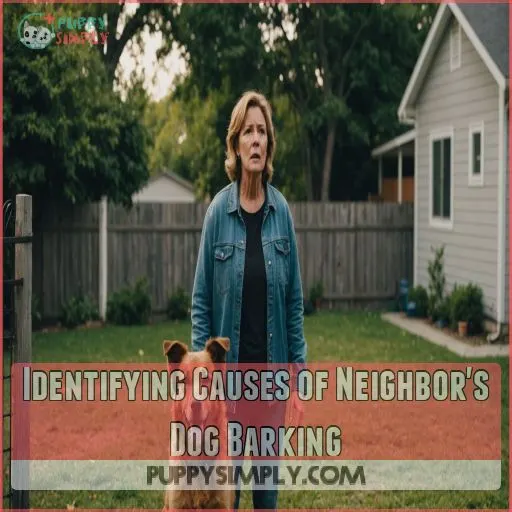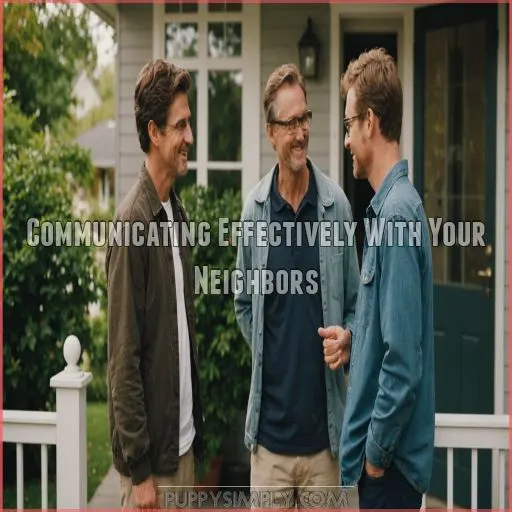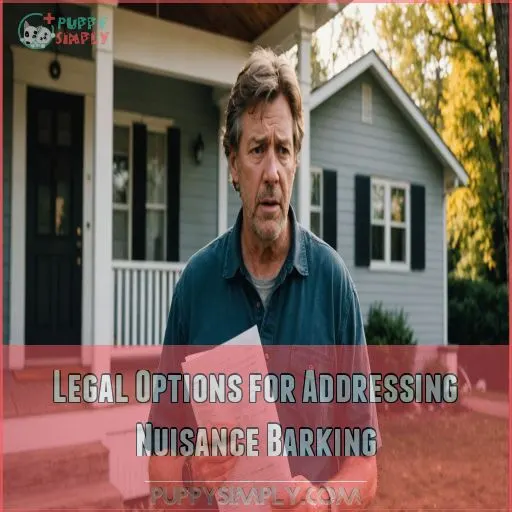This site is supported by our readers. We may earn a commission, at no cost to you, if you purchase through links.
 Struggling with your neighbor’s barking dog? Don’t fret; you’re not alone! First, identify the root cause—whether it’s a bored pup or a neighborhood protector.
Struggling with your neighbor’s barking dog? Don’t fret; you’re not alone! First, identify the root cause—whether it’s a bored pup or a neighborhood protector.
Open the door to communication: chat with your neighbor without pointing fingers, and maybe suggest a few calming remedies like joint walks or interactive toys.
Consider environmental tweaks, such as visual barriers, or use technology like smart systems to monitor barking. A little creativity goes a long way in quelling ruff situations!
Now, ready for some more delightful tricks that might just save your sanity and your neighborly peace? Stay tuned!
Table Of Contents
- Key Takeaways
- Identifying Causes of Neighbor’s Dog Barking
- Communicating Effectively With Your Neighbors
- Implementing Environmental Changes to Reduce Barking
- Training Techniques to Stop Dog Barking
- Utilizing Technology to Address Barking Issues
- Seeking Professional Help for Persistent Barking
- Legal Options for Addressing Nuisance Barking
- Frequently Asked Questions (FAQs)
- What should I do if my dog barks at my Neighbor?
- What if my Neighbor’s dog won’t stop barking?
- How can I get a dog to stop barking?
- How do you stop a dog from Barking next door?
- What is the best way to stop a neighbor’s dog from barking?
- What can I do if my neighbour’s dog constantly barking?
- Will a dog whistle stop my neighbor’s dog from barking?
- Are dog silencers legal?
- What are some effective ways to communicate with neighbors about their barking dog?
- Are there specific rules or laws regarding barking dogs in my area?
- What should I do if my neighbors dog is constantly barking when Im trying to sleep?
- What are some environmental changes I can suggest to my neighbor to reduce their dogs barking?
- Are there any technologies or tools that can help address my neighbors barking dog?
- Conclusion
Key Takeaways
- Chat openly with your neighbor about their barking dog. A friendly "Howdy, neighbor!" can go a long way in finding solutions, such as training classes or doggy daycare, which can turn you from a neighborhood grump into a peace ambassador.
- Get creative with environmental tweaks. Suggest putting up fences or hedges as visual barriers to help keep Fido’s vocal performances in check. It’s like setting the stage curtains to reduce the drama.
- Use a bit of tech savvy to tackle the barking. Tools like ultrasonic deterrents and mobile apps can help monitor and reduce noise without the need for a neighborhood barking ordinance showdown.
- Consider involving professionals if the barking saga continues. A certified dog trainer or veterinary behaviorist might just be the plot twist your neighborhood needs, quieting the woofs into whispers and ensuring everyone gets their beauty sleep.
Identifying Causes of Neighbor’s Dog Barking
You’re at your wit’s end with your neighbor’s noisy pooch, but hold on – understanding why Fido’s barking up a storm is the first step to peace and quiet.
Let’s uncover the root causes of that canine chorus so you can tackle the problem head-on and reclaim your sanity.
Territorial Behavior and Protective Instincts
Many dogs are natural-born watchdogs, constantly on high alert for potential threats.
Your neighbor’s pooch might be barking its head off due to territorial behavior and protective instincts .
It’s not the dog’s fault; they’re just doing their job! Some breeds are more prone to this behavior, treating every passerby as a potential intruder.
Understanding your furry neighbor’s motivations is the first step in tackling the noise.
Boredom and Lack of Mental Stimulation
While territorial barking can be a headache, sometimes the root cause is simpler: your neighbor’s dog is bored out of its mind.
A lack of mental stimulation can turn any pup into a noisy nuisance. Boredom barking is often self-stimulating and results from a dull environment .
To keep those woofs at bay, consider these enrichment ideas:
- Puzzle feeders that make mealtime a mental workout
- Interactive games to challenge their doggy brain
- A dog walker for midday adventures and socialization
Separation Anxiety and Loneliness
Just as your bored pooch might bark up a storm, a lonely pup can be quite the chatterbox too.
Separation anxiety’s a real struggle for our four-legged friends. If your neighbor’s dog howls like a banshee when left alone, it’s likely feeling stressed and scared .
Look out for telltale signs like excessive barking, destructive behavior, or even potty accidents indoors. These aren’t acts of rebellion – they’re cries for help! They are indicative of separation anxiety.
Environmental Triggers and External Stimuli
If you’re dealing with a neighbor’s barking dog, there are a few reasons why your furry friend might be making a racket. External stimuli can set off even the most well-behaved pooches.
- Rustling leaves or banging windows
- Doorbells or delivery trucks
- Lightning or thunder
- Passing cars or pedestrians
Understanding these triggers is key to tackling the noise pollution . By identifying what sets off the barking, you’ll be one step closer to restoring peace in your neighborhood.
Medical Issues or Underlying Health Problems
Your dog’s excessive barking could stem from an underlying medical condition, so it’s important to rule out any health issues check the barking triggers before trying any training methods.
Schedule a vet checkup to rule out issues like allergies, pain, or neurological problems. The vet can also perform tests to identify any health factors contributing to the barking.
With the right treatment, you can restore peace and quiet.
Communicating Effectively With Your Neighbors
Talking to your neighbors about their dog’s barking might feel awkward, but it’s often the first step to peace and quiet.
A friendly chat can prevent drama and lead to solutions that keep you from transforming into the neighborhood "bark-humbug"!
Initiating a Friendly Conversation About the Barking
Imagine starting the conversation with a friendly "Howdy, neighbor!" It’s like offering a peace treaty over the fence.
Empathize with their situation—maybe they’re blissfully unaware of their pup’s performance.
Humor can help ease tension, like mentioning how their dog may be auditioning for the barking Olympics.
Focus on solutions, avoiding conflict, while building rapport and offering support .
Expressing Concerns Without Accusations or Blame
Start conversations with empathy and a respectful tone. Instead of blaming, share how the barking affects your well-being. "I’ve noticed the barking keeps me up. Any ideas on handling it together?"
This invites open dialogue and active listening without finger-pointing. Humor helps: "The dog’s got a bark as loud as a marching band!"
Respect neighbor noise issues and etiquette.
Offering Assistance and Support to Address the Issue
Tackling a neighbor’s barking dog can feel like dealing with a barking symphony.
Lending a helping hand with suggestions, like dog walker recommendations or calming techniques, might be your golden ticket.
Share local neighborly resources with a chuckle, or offer training help.
These dog barking tips can ease tensions and lead to satisfying, shared solutions without ruffling feathers .
Proposing Collaborative Solutions for Both Parties
Now that you’ve offered help, think about teaming up with your neighbor for practical solutions.
Suggest noise reduction strategies like shared walks or joint training sessions.
How about fence sharing to curb the barking beast?
If all else fails, remind them of local dog barking laws and regulations.
Working together, you can handle the problem.
Maintaining Open Lines of Communication
After proposing solutions, keeping communication open is key. Think of it like maintaining a garden—regular tending prevents weeds of misunderstanding.
Engage in respectful dialogue using active listening to make sure empathy and understanding are present. Stay positive, even when discussing dog barking complaints.
Ensuring mutual respect nurtures a neighborly bond that’s as comforting as your morning coffee .
Implementing Environmental Changes to Reduce Barking
If your neighbor’s dog just won’t stop barking, it’s time to take matters into your own hands.
Implementing strategic environmental changes can work wonders in reducing that incessant yapping and restoring peace to your neighborhood.
Installing Visual Barriers Like Fences or Hedges
When dealing with dog barking, consider erecting visual barriers like fences or hedges. They add privacy and enhance aesthetics.
They also block distractions. Opt for materials that fit your budget—wood for charm, vinyl for durability.
Make sure installation respects property lines to maintain neighborly love. With a bit of effort, enjoy barking-free bliss in your safe haven .
Creating a Calming Environment for the Dog
Creating a calming environment for your dog helps curb barking.
Try these three tricks:
- Dog calming music: Play soothing tunes or white noise to relax your pup .
- Dog calming toys: Engage their mind and diminish boredom with interactive toys.
- Dog calming scents: Use pheromone diffusers for a serene atmosphere.
These small changes can make a big difference!
Removing or Minimizing External Stimuli
To tackle dog barking, start by eliminating distractions.
Install visual barriers, like curtains, to block outside views.
Incorporate noise reduction techniques such as soundproofing or using noise-canceling headphones.
Routine changes can help too, like adding ultrasonic dog repellers or training with a dog whistle. These strategies keep your dog calm and make neighbors less cranky by using professional training techniques.
Providing Appropriate Toys and Enrichment Activities
Reducing outside noise helps, but dogs need mental stimulation too.
Interactive toys and puzzle feeders are game-changers. Try these:
- Kong Toys: Stuff with dog treats or food; it keeps them busy, like a puppy detective solving a tasty mystery .
- Chew Toys: Ideal for oral focus and dog safety .
- Enrichment Games: Boosts brainpower and cuts boredom.
Establishing a Consistent Routine for the Dog
Routine’s the magic wand for barking woes! Dogs thrive on structure—think feeding times, walk schedules, and bedtime rituals.
Establish playtime routines with training sessions for mental enrichment.
| Activity | Morning | Afternoon | Evening |
|---|---|---|---|
| Feeding times | 7:00 AM | 1:00 PM | 6:00 PM |
| Walk schedule | 8:00 AM | 2:00 PM | 7:00 PM |
| Playtime routine | 10:00 AM | 3:00 PM | 8:00 PM |
| Bedtime rituals | 9:00 PM |
Keep it fun, and watch the barking vanish! .
Training Techniques to Stop Dog Barking
Tired of barking driving you bonkers? Arm yourself with simple, effective training techniques to bring peace back to your neighborhood—you might even impress the dog!
Positive Reinforcement and Reward-based Methods
If your pup is a barker, try positive reinforcement training.
Reward Maple with tasty treats or playtime when she’s calm and quiet .
This encourages the behavior you want to see, rather than punishing her for barking.
With consistency, she’ll learn that good things happen when she keeps her yap shut, through good things happen.
Desensitization to Common Barking Triggers
You’re on the path to harmony! Understanding your dog’s world through desensitization techniques can be like unraveling a mystery.
- Identify triggers that spark the barking frenzy.
- Gradually expose your dog to those triggers.
- Reward calm behavior with treats.
- Watch as your dog’s confidence blooms!
Transform chaos into calm with these steps! .
Teaching Quiet and Speak Commands
After understanding barking triggers, teaching your dog quiet and speak commands is next.
Use positive reinforcement, like a treat, when they follow your verbal cues. Be patient—timing and consistency are key!
Imagine your pup as an opera singer on cue. Use hand signals to guide them, and remember, a well-timed reward makes the training a hit .
Redirecting the Dog’s Attention to Alternative Behaviors
Ever heard the phrase "a tired dog is a quiet dog"? Redirect your barking pooch’s attention with dog toys, interactive games, and training treats to keep them mentally stimulated.
Puzzle feeders work wonders for keeping your dog engaged, helping you stop dog barking neighbors dread.
Toss in some pet-safe ultrasonic birdhouse for effective control without the chaos .
Consistency in Training Across All Family Members
Redirecting your dog’s attention away from triggers is peachy, but training consistency is where the magic happens.
It’s a family-wide gig. Everyone needs to sing from the same hymn sheet. Think of it as a team sport—consistency and shared responsibility lead the pack.
Check out dog barking communities and forums for tips, tricks, and a bit of moral support!
Utilizing Technology to Address Barking Issues
If you’ve ever been driven bonkers by a neighbor’s barking dog, technology might offer the relief you need.
From ultrasonic gadgets to smart home systems, these tools can help quiet the chaos and save your sanity.
Anti-barking Devices and Their Effectiveness
Moving past training techniques, anti-barking devices can help keep the peace and quiet you’ve been craving.
These gadgets vary in type and effectiveness, often sparking ethical concerns.
Consider:
- User reviews and animal welfare
- Alignment with neighborhood noise rules or apartment lease terms
- Types: collars, motion-sensors, etc.
- Potential side effects
- Your dog’s specific needs and response
Smart choices await!
Ultrasonic Deterrents and Sound-based Solutions
Tired of your neighbor’s dog barking up a storm?
Ultrasonic deterrents could be the answer. These clever devices emit high-pitched sounds that only dogs can hear, startling them into silence.
Just aim it at the offending pup, and watch the barking stop. No shock, just a harmless sonic solution that’s safe and effective.
Smart Home Systems for Monitoring and Intervention
Smart home systems can be your trusty sidekick, offering you a watchful eye on your barking dog, even if they can’t fetch a bone.
With sensors and cameras, you can assess barking detection accuracy and integrate with other systems .
Keep your wallet happy with cost-effective options, but watch out for privacy concerns that might wag the dog’s tail!
Mobile Apps for Tracking and Managing Barking Behavior
Keeping tabs on barking chaos can be a breeze with mobile apps designed for tracking and managing barking behavior.
Get the most out of them with:
- Barking app features: Real-time notifications and sound analysis.
- Dog barking data: Track patterns over time.
- App accuracy: Proven sound recognition technology.
- Privacy concerns: Safe data handling policies.
Let apps help you silence the ruckus!
Legal Considerations for Using Anti-barking Technology
Exploring anti-barking tech? Weigh your options carefully—Privacy concerns and legal repercussions can crop up if neighbors feel their dogs are unfairly targeted.
Table below highlights key points:
| Aspect | Consideration | Impact |
|---|---|---|
| Privacy Concerns | Neighborly tension | Community discord |
| Ethical Use | Fair practice | Trust maintenance |
| Effectiveness | Varies by case | Mixed results |
Use devices wisely to maintain neighborhood harmony.
Seeking Professional Help for Persistent Barking
When your neighbor’s dog’s barking feels like a never-ending alarm clock, maybe it’s time for some professional backup.
From dog trainers to veterinarians, pros can turn even the loudest woofs into whispers, giving you back your peace and quiet.
Consulting With a Certified Dog Trainer
While gadgets offer quick fixes, enlisting a certified dog trainer provides enduring barking solutions.
Trainers harness expertise to pinpoint triggers and apply customized techniques. You’ll benefit from their knowledge of training methods and the cost-to-benefit balance.
To find a trainer, seek recommendations and make sure they’re certified. A good trainer transforms chaos into harmony – now that’s barking up the right tree!
Working With a Veterinary Behaviorist
Moving from a dog trainer’s suggestions, you might consider working with a veterinary behaviorist. They can customize behavior modification techniques suited to your dog’s needs.
Here’s the scoop:
- Behavior Modification: Strategies for your furry friend that are specific to their needs.
- Medication Options: Sometimes necessary for anxiety.
- Cost Considerations: Consultations can be pricey, but peace of mind is priceless.
Ready to tackle that barking?
Attending Group Training Classes for Socialization
Attending group training classes can work wonders for socializing your pup.
With a qualified trainer’s guidance, your dog can learn to navigate the dynamics of a class setting, building confidence and curbing any lingering fears or anxieties.
The cost-effective group format also allows you to learn alongside fellow dog owners, sharing tips for success.
Exploring Specialized Behavior Modification Programs
Exploring the world of dog behaviorists could be your ticket to peace.
Specialized programs, crafted by experts, tackle barking triggers with finesse.
Consider these perks:
- Therapy Dogs: Train for calm, steady vibes.
- Training Techniques: Adapted to your pooch’s quirks.
- Behavioral Tools: Sub-threshold exposure magic .
- Cost of Programs: Worth every penny if serenity returns.
Addressing Underlying Medical Issues With a Veterinarian
So, you’ve explored behavior programs, yet Bowser’s barking symphony persists?
Time to book a vet visit! Health checks uncover hidden culprits like pain or neurological issues .
Medical tests could reveal conditions like canine distemper, triggering barks .
Treatment options and follow-up care translate chaos into calm, ensuring Bowser’s more Lassie than Jurassic Park velociraptor. Trust the vet’s expertise!
Legal Options for Addressing Nuisance Barking
If your neighbor’s dog’s barking has turned into a neighborhood symphony you didn’t sign up for, legal options might be your next stop.
From local noise ordinances to formal complaints, you’ll find practical steps to restore some peace in your life.
Familiarizing Yourself With Local Noise Ordinances
Before tackling the barking beast head-on, check out the local noise ordinances.
Familiarize yourself with noise levels, enforcement methods, and exceptions.
Understanding the complaint process and legal recourse is like having a map before a road trip, ensuring you’re not barking up the wrong tree.
Plus, knowledge is power when handling neighborhood noise challenges! .
Documenting Instances of Excessive Barking
Understanding local noise ordinances is just the tip of the iceberg.
Start a Barking Log with these steps:
- Note Noise Levels: Record the volume.
- Include Time Stamps: Precision is your friend.
- Mention Dog’s Breed: It can matter.
- Get Owner’s Contact: When ready to address it directly.
It’s like solving a mystery, one clue at a time!
Filing Formal Complaints With Appropriate Authorities
Got a barking symphony disrupting your peace? Time to file a complaint! Check out local noise ordinances and dog ownership laws to know your rights.
Document the disturbances like a detective, then submit a formal complaint. Here’s a quick guide:
| Authority | Action |
|---|---|
| Animal Control | Initial complaint and investigation |
| City Council | Adjust noise ordinances if needed |
| Police Department | Enforce ordinances and issue fines |
| Mediation Services | Facilitate discussions between neighbors |
| Legal Advisers | Offer guidance on legal precedent |
Navigate this with tenacity and diplomacy! .
Mediation Services for Resolving Neighbor Disputes
Seeking mediation can be a game-changer when dealing with a barking dog issue. Mediators act as neutral third parties , guiding you and your neighbor through productive discussions to find mutually agreeable solutions. This confidential process often leads to better outcomes than legal battles, saving you time, money, and preserving community relations.
- Mediators help identify the root causes and offer potential solutions.
- Mediation is voluntary, so you maintain control over the outcome.
- Successful mediation can improve neighborhood livability and prevent future conflicts.
Understanding Your Rights and Responsibilities as a Neighbor
When neighbor mediation feels like talking to a brick wall, it’s time to understand your rights.
Familiarize yourself with local noise regulations to know what legal recourse you have against a barking menace.
Check your property boundaries and document incidents, but tread lightly—balancing ethical dilemmas and neighborhood harmony is key.
After all, nobody wants to be the barking police .
Frequently Asked Questions (FAQs)
What should I do if my dog barks at my Neighbor?
An ounce of prevention is worth a pound of cure.
Identify barking triggers and distract your dog with treats or toys.
Engaging training sessions can redirect their attention and make them bark less at neighbors .
What if my Neighbor’s dog won’t stop barking?
Start by chatting with your neighbor; suggest using an ultrasonic device to curb barking.
If all else fails, consider mediation or contact animal control.
Keep calm and remember, the dog’s not the real culprit .
How can I get a dog to stop barking?
Imagine your dog’s barking as them trying to play percussion in your daily symphony.
Understand why they’re barking, then train consistent "quiet" commands.
Make sure they get enough exercise, and remove triggers for a harmonious home life .
How do you stop a dog from Barking next door?
To stop your neighbor’s dog from barking, have a friendly chat with the neighbor.
Suggesting solutions like dog training, ultrasonic devices, or blocking the dog’s view with a fence.
Patience and understanding often work wonders, and this approach may help resolve the issue.
What is the best way to stop a neighbor’s dog from barking?
Try chatting with your neighbor first – they may not even realize their pup’s barking is a problem.
They may appreciate friendly suggestions like doggy daycare or training classes to curb the noise.
If that fails, politely file a noise complaint .
What can I do if my neighbour’s dog constantly barking?
You’ve finally reached the end of your rope with your neighbor’s barking dog.
Approach your neighbor with kindness, suggest solutions like training or barriers.
Document the situation for any needed legal action .
Will a dog whistle stop my neighbor’s dog from barking?
Yes, a dog whistle might help stop your neighbor’s dog from barking by distracting it.
Use it sparingly to avoid causing distress, and make sure it’s within safe frequency levels so you don’t get an unwanted surprise lawsuit.
Are dog silencers legal?
Dog silencers, like electronic bark control devices, have legal restrictions that differ by location.
In places like New South Wales, such devices are typically illegal due to animal welfare concerns.
Always check local laws before using them .
What are some effective ways to communicate with neighbors about their barking dog?
Approach your neighbor calmly and share observations with specific examples.
Offer possible solutions like dog training tips or bark deterrents.
Suggest setting a meeting for follow-up while maintaining a friendly tone to encourage cooperation .
Are there specific rules or laws regarding barking dogs in my area?
Like a siren in the night, barking laws often echo community concerns.
In your area, it’s illegal for a dog to disturb neighborhood peace, potentially leading to fines or legal action if unresolved .
What should I do if my neighbors dog is constantly barking when Im trying to sleep?
Politely talk to your neighbor about the barking, as they mightn’t know it’s a problem.
Suggest keeping the dog inside at night.
If unresolved, consider contacting local authorities or using mediation for a peaceful resolution .
What are some environmental changes I can suggest to my neighbor to reduce their dogs barking?
To reduce your neighbor’s dog’s barking, suggest they block sounds that trigger it by playing soothing music and teach the dog a "quiet" cue to control the behavior .
Are there any technologies or tools that can help address my neighbors barking dog?
Consider using the Dog Silencer MAX, a humane device emitting ultrasonic sounds to deter barking.
It works up to 300 feet away, perfect for assisting with a neighbor’s noisy dog without confrontation .
Conclusion
Imagine Sarah, a sleep-deprived neighbor, finally at peace thanks to your proactive steps to stop dog barking neighbors.
By unraveling the mystery behind barking woes, chatting openly, and trying out creative solutions like visual barriers or tech gadgets, you’ve turned chaos into camaraderie.
Remember, a blend of patience and perseverance with your neighbors—and maybe a shared doggy treat—can work wonders.
Who knows? Your neighbor’s dog might just become your best new furry friend!













